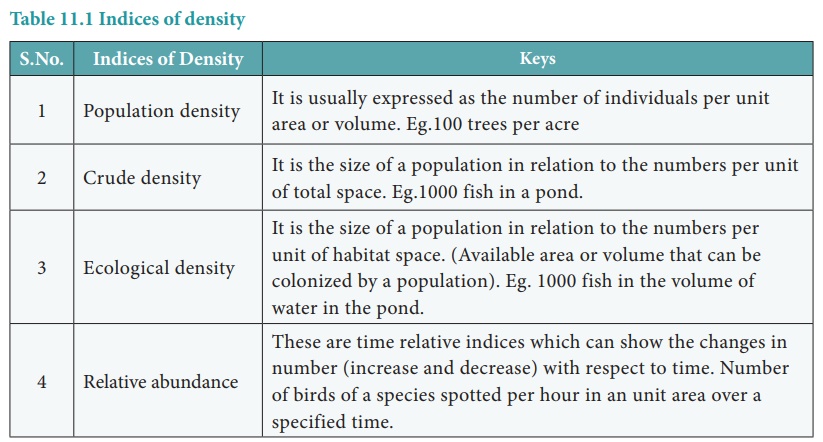Organisms Reproductive and Population - Population Attributes | 12th Zoology : Chapter 11 : Organisms Reproductive and Population
Chapter: 12th Zoology : Chapter 11 : Organisms Reproductive and Population
Population Attributes
Population Attributes
Population density
The density of a population refers to its size
in relation to unit of space and time. Population density is the total number
of that species within a natural habitat. The size of the population can be
measured in several ways, including abundance (absolute number in population),
numerical density (number of individuals per unit area (or) volume) and biomass
density (biomass per unit area (or) volume). The population density of a
species can also be expressed with reference to the actual area of habitat
available to the species (ecological density - Table 11.1). When the
size of individuals in the population is relatively uniform then density is
expressed in terms of number of individuals (numerical density).

Natality
Populations increase because of natality.
Natality is equivalent to birth rate and is an expression of the production of
new individuals in the population by birth, hatching, germination (or) fission.
The two main aspects of reproduction, namely fertility and fecundity play a
significant role in a population. Natality rate may be expressed in crude birth
rate number of organisms born per female per unit time.
Birth rate (b) = number of birth per unit time /
average population

Mortality
Mortality is the population decline factor and
is opposite to natality. Mortality can be expressed as a loss of individuals
in unit time or death rate. Generally, mortality is expressed as specific
mortality, that is, the number of members of an original population dying after
the lapse of a given time. The crude death rate of a population can be
calculated by the equation.
Death rate (d)= number of deaths per unit time /
average population

The rate of mortality (death) is determined by
density. Mortality is high at high density because of the hazards of
overcrowding, increased predation and spread of disease.
Mortality rates vary among species and are
correlated and influenced by a number of factors such as destruction of nests,
eggs or young by storms, wind, floods, predators, accidents and desertion by
parents.
Population Dispersion
Populations have a tendency to disperse or
spread out in all directions, until some barriers are reached. This is observed
by the migration of individuals into (Immigration) or out (Emigration) of the
population area.
Migration
Migration is a peculiar and unique kind of mass
population movement from one place to another and back. To avoid the severe
winter cold, Siberian cranes migrate from Siberia to Vedanthangal in Tamil Nadu
and return back in spring. Some fishes are known to migrate from sea to fresh
water (anadromous migration, Salmon) and some from fresh water to sea
(catadromous migration, Eel).
Emigration
Under natural conditions, emigration usually
occurs when there is overcrowding. This is regarded as an adaptive behavior
that regulates the population in a particular site and prevents over
exploitation of the habitat. Further, it leads to occupation of new areas
elsewhere.
Immigration
It leads to a rise in population levels. If the
population increases beyond the carrying capacity, it can result in increased
mortality among the immigrants or decreased reproductive capacity of the
individuals. Both emigration and immigration are initiated or triggered by
weather and other abiotic and biotic factors.
Related Topics